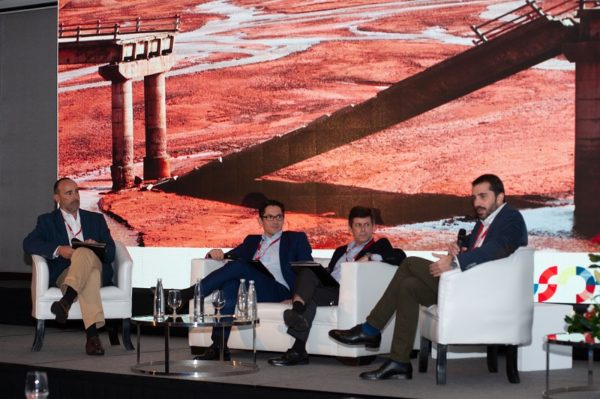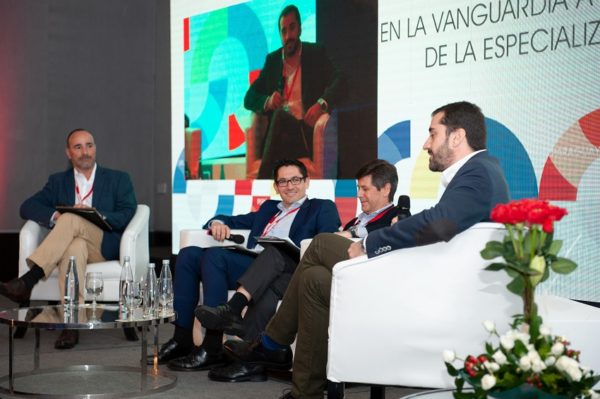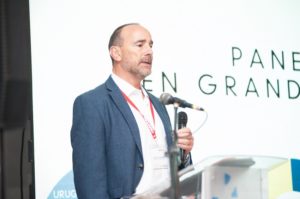admin | 01/02/2019
On November 30th, the second LATAM South Global Risks Workshop took place in Bogota. The event brought over 200 experts together and gave them the opportunity to analyze and discuss the challenges and business trends in the region’s major risks business, including Major Infrastructure Claims, their complexity, and the keys to mitigating them.
Learning lessons from claims and adopting measures based on this information is one of the most efficient tools in improving policies and consequently, improving claims management.
Organized using the International Workshops that MAPFRE’s Global Risks Unit has been successfully holding for 25 years as a point of reference, the forum is the largest event for the Major Risks business held in LATAM South.
The agenda of the Workshops included talks about key topics in the region. One of the panels that took place during the workshop that I had the pleasure of moderating was the one about Major Infrastructure Claims.
Andres Barberena, Claims Manager at Marsh Chile, Luis Martín Rodríguez, Regional Head of Claims for Latin America at Munich Re, and Ignacio Lorenzo Tomil, CEO of the Corporate/Specialty Department and the International Department of the Addvalora Group, participated in this round table discussion.
Some of the main aspects entailed by Major Infrastructure Claims, given their technical complexity and the broad socio-economic and reputational impact involved, were discussed and analyzed, and measures to prevent or mitigate these difficulties were explored from three points of view: that of the broker, the reinsurer, and the adjuster.

The keys to their complexity
- Intervention from different international players – Major Infrastructure Claims are clearly major risks that usually require strength from international markets. This leads to intervention from people from different cultural backgrounds who speak different languages, use different currencies, and are subject to different laws that are not easily compared between one country and another. The experience, or lack thereof, of some players in certain countries, often far removed from the market they know, can lead to suspicions and lack of trust among stakeholders. Lawyers and adjusters or experts from different countries are often appointed. These people analyze the claim for their employers in line with the criteria and law that they know and this doesn’t always coincide with the criteria and law of the country where the claim occurred.
- Specific Clauses and Discrepancies in Interpretation. Another difficulty in this kind of claim lies in the type of risk, in the specific policies and clauses that they usually contain, such as LEG exclusions, additional coverage for Loss Reduction Expenses, Sue and Labor, or the Acts of Authority clause
Lawyers and adjusters or experts from different countries are often appointed. These people analyze the claim for their employers in line with the criteria and law that they know and this doesn’t always coincide with the criteria and law of the country where the claim occurred.

Objectively, there is no doubt about the scope and interpretation of these additional clauses, exclusions, and coverage. The problem arises when they are applied to the reality of specific cases in which fitting certain costs
under certain items is not easy and where possibly covered items mix with expressly excluded ones. Additionally, there are clauses that may be have been drafted in languages other than that of the country where the loss occurred. Even within the same language, there are often discrepancies about the interpretation of certain clauses applied to a claim, and these must sometimes be resolved in court or by arbitration. This problem increases when other languages, cultures, usage, customs, and laws are involved. There is also limited case law on this, since so few of these matters are brought to court. The parties generally wind up settling the case outside of court.
- Valuation in the Coexistence of New Construction and Pre-Existing Assets. In the construction and operation of linear infrastructure, new construction and pre-existing structures tend to
 coexist and are often included as insured assets on the policy. The new construction has projects and exact, up-to-date measurements and valuations that are not available for pre-existing structures. The true updated value of this infrastructure becomes apparent, sometimes for the first time, in claims affecting pre-existing assets, as is often the case in natural disasters, when the infrastructure must be repaired or replaced, resulting in something considerably different from what was there before.
coexist and are often included as insured assets on the policy. The new construction has projects and exact, up-to-date measurements and valuations that are not available for pre-existing structures. The true updated value of this infrastructure becomes apparent, sometimes for the first time, in claims affecting pre-existing assets, as is often the case in natural disasters, when the infrastructure must be repaired or replaced, resulting in something considerably different from what was there before.
- Monetary Diversity. As these claims involve different international players, there are also several currencies involved, with the corresponding fluctuations in their exchange rates. In a large claim this may entail a considerable difference in the amount, depending on the exchange rate used and the time when the conversion is made.
Measures to Minimize Problems in Managing Claims
The specialists pointed out several measures to be considered in order to minimize the complexities present in Major Infrastructure Claims, prior to the occurrence of said claim. These include:
- Training and Specialization. Of all the measures to be considered, the one that was most evident for all of those present was training and specialization at all levels for all players taking part in claims management: brokers, adjusters, and insurers, both in the Underwriting and Claims Departments.
- Greater Investments in Engineering. Another measure effective in reducing these claims and their consequences would be greater investments in engineering, both in the drafting of projects and in the permanent revision of their execution in accordance therewith, as the leading cause of major infrastructure claims not involving natural disasters are errors of design, materials, or execution.

- Claims Protocols. Another element that has proven to be one of the most useful for organizing the management of these complex claims is the existence of Claims Protocols. Criteria for appointing adjusters and interlocutors, the flow of communications, minimum documentation required, response times, criteria to establish the exchange rate, etc., can all be set forth in these protocols. Claims protocols can and should contain management criteria and procedures and adapt to the specificities of each type of infrastructure and geographical location, as well as the corresponding applicable law. The protocols are not supposed to predict all of the situations that may arise from a claim, but rather mark the guidelines to manage them. Moreover, they must be reasonably flexible, clear, and simple to apply.
“Policy stress tests” are exercises carried out jointly by the Underwriting and Claims Departments that consist of subjecting policies to claims simulations with all of the peculiarities and complexities that may arise, based on previous experience.
- Policy Stress Test. These are the exercises carried out jointly by the Underwriting and Claims Departments that consist of subjecting policies to claims simulations with all of the peculiarities and complexities that may arise, based on previous experience of what caused greater problems in past claims. The purpose of this is to verify the policies’ performance, to see if they adjust to the intentions of the parties, and, if necessary, to adopt measures to prevent the previous problems from occurring again.However, even though these “stress tests” with simulated claims are highly useful, it is really during the claim itself when all the strengths and, especially, the areas for improvement, of the policies come to light.
Learning lessons from claims and adopting measures based on this information is one of the most efficient tools in improving policies and consequently, improving claims management.
José Luis Cubero, Head of Benefits at the Property Damages Claims Department of MAPFRE Global Risks

José Luis has a degree in Technical Architecture from the Technical University of Madrid and worked in project management on civil engineering and building projects, as well as in drafting civil engineering projects. He joined MAPFRE 21 years ago and has been working in the Claims Department ever since. He has been Head of Damages and Engineering Benefits of MAPFRE Global Risks since 2011.





